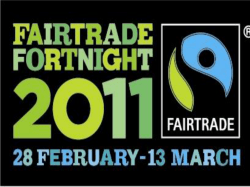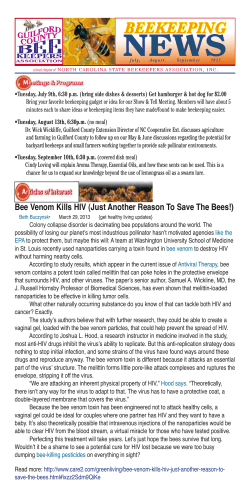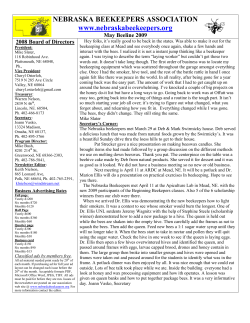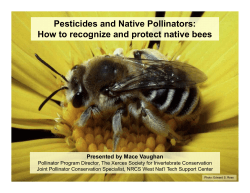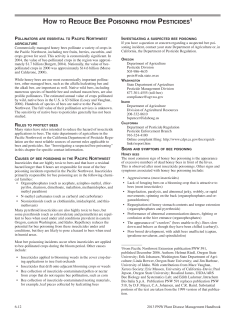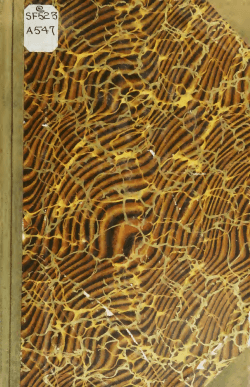
How To Be A Bee Friendly- Farmer
How To Be A Bee Friendly- Farmer Kim Flottum Visiting several BFF-certified growers in northern California to see how the program works and where it all began. The most obvious need for available honey bee food is where there are the most honey bees. This happens when bees from nearly everywhere in the U.S. arrive in California beginning in mid to late Fall and continuing right up to bloom time in the almond orchards. Many, maybe most, leave home right after honey harvest and before Winter sets in and they get snowed under. When they arrive in California they head for places to sit – and those places are mostly barren, based in Santa Rosa, California with abot 100 members and 40 or so farmers. The BFF initiative recognizes and rewards land owners who commit a small percent of their land – farm, ranch, pasture, orchard, vineyard or fallow land – to growing honey bee friendly plantings, along with other bee beneficial practices. “Bee Friendly Farmer” is an inclusive term that is intended to recognize Bee Friendly ANYONE who supports bees directly or indirectly – beekeepeers, farms, ranches, businesses, schools, local governments, nonprofits, and gardeners. The BFF initiative is an important means of raising consumer recognition and support for helping bees by (1) recognizing those who provide bee Mark Griffin, head grower at Napa Valley Reserve, and Kathy Kellison, founder of Bee Friendly Farming. Wild flowers grow between grape vine rows at Napa Valley Reserve. forage-free landscapes. It’s Winter in California, remember. And, where almonds grow, unless there’s irrigation there’s not a lot out there. Recall, too, that there are hundreds of thousands of colonies already there that belong to California beekeepers; and they are usually in locations that afford better forage, water and accessibility. It’s their home field advantage. 46 The bees spend the time from when they arrive to the time they are moved into almond orchards building their population to cover at least eight frames with bees and brood by about February first. Since there’s not much available beekeepers spend a lot of time and money stuffing them full of protein and carbohydrates, and other essential nutrients from artificial diets. But even after almonds there’s a need for diverse forage in much of the state because there’s either non-diverse agriculture, or lots of not much during hot, dry Summers. This is what led to the launch of the Bee Friendly Farming™ (BFF) initiative by Partners for Sustainable Pollination (PFSP) founder Kathy Kellison. PFSP is a non-profit group BEE CULTURE At Kunde Vineyards, bee friendly plants have been put around irrigation ditches. Low to no maintenance plants are used. That’s a California Buckeye in the foreground, which can be a nuisance to honey bees if no other plants are blooming. November 2010 It’s hard finding unused space at most of the farms in this part of California. Every square inch that can be used is . . . so ekeing out even a tiny fraction of that land for bees is a bonus. This hillside vineyard is seen from the main buildings at Kunde Vineyards. I visited several BFF-certified growers in northern California this past spring to see how the program works and where it all began. Napa Valley Reserve is a privately owned vineyard in the Napa Valley. Mark Griffin, head grower, dedicated land here by planting buckwheat between vine rows, which serves the dual purpose of pulling excess moisture out of the soil – grapes don’t like too-wet feet – and feeding bees at the same time. When blossoming is complete the plants are plowed under and the space replanted. Other plants used include borage and a wildflower mix. He also uses space not otherwise useful near creeks and road beds and around the temperature control fans. Local bees, including his that he keeps on the property and native bees, all benefit from these plantings that provide food that otherwise wouldn’t be available. Napa Valley Reserve is able to use the BFF logo on its products as a reward. habitat, and/or (2) supporting bees by purchasing farm products and local honey bearing the BFF logo. Still in its infancy, Kathy Kellison has made giant strides on the grower end – see the map of bee friendly farms – and in building support, where she’s made friends and allies with prestigious, similar minded folks like non-profits Xerxes Society and the North American Pollinator Protection Campaign (NAPPC), with trade associations like the California Farm Bureau, and with government agencies at the national and state level, like the USDA’s Natural Resources Conservation Service (NRCS). Rows of wildflowers planted in rotation with each other and sometimes vegetable crops. Some are past blooming, some are blooming, and some are just emerging. The “Menu” at Oak Hill Farms, an organic CSA. Members join for a fee, and share the harvests as they come in. November 2010 BEE CULTURE McEvoy Ranch in Petaluma produces a host of different olive varieties and makes specialty olive oils from the different types of olives. Shari DeJoseph has set aside areas between tree rows to grow an assortment of bee friendly perennials, and uses bee friendly trees as wind breaks in the hilly terrain. They employ many sustainable agriculture practices because it’s profitable in the long run, and the right thing to do. Their wind generator is a good example. Oak Hill Farm is an organic 47 Some of the wildflowers at Oak Hill Farms aren’t for honey bees, like this vetch, but are beneficial for other pollinators and for soil enhancement, and erosion control. fruit, vegetable and flower farm near Glenn Ellen. They obviously don’t use dangerous chemicals, but they also rotate crops on and off plots of land, using bee friendly flowers between vegetable crops. It works for them as soil improvement and pollinator attraction and for the bees they have on the property, and other pollinators that share their land, and pollinate their crops. BFF stickers are used on everything they sell. A historical family owned vineyard in Sonoma County, Kunde Vineyards, is more conventional in their practices, but they are very aware, and very conscientious of the value of pollination. Steve Thomas, the manager, maintains significant pollinator plantings, mostly around the many irrigation ditches his operation requires, plus the riparian sites on the property and several large hedge- Perennial shrubs take up some space at Singing Frog Farm, but provide additional pollinator food between fruit and vegetable crops, keeping them well fed and in the area. A green roof, and more plantings keep pollinators well fed at Singing Frog Farms. Pollinator friendly flowes are planted at the ends of rows in the vegetable plots at Singing Frog Farms. 48 BEE CULTURE rows they have on land not otherwise useful. Plantings are mostly low or no maintenance shrubs, trees and perennials . . . labor costs are always a concern. And, of course, using the BFF logo is a benefit for all of their products. Paul Keiser runs family owned Singing Frog Farms, a member supported Community Supported Agriculture operation in Sebastopol. They raise over 100 varieties of fruit and vegetables, and were one of the first businesses to use the BFF logo on their web page. They provide bee friendly food betweens rows of vegetables, on row ends, and in rotation with their many crops. The National Association of Conservation District and the North American Pollinator Some of John Gormain’s bees on Swallow Valley Farm. The very hilly land in the background supports sheep, but pollinator friendly hedge rows went in this Summer that provide not only good food, but soil and wind erosion control. November 2010 Planting in otherwise unused space . . . here the service road to the wind generator for temperature control . . . in a vineyard makes perfect sense, and takes up no otherwise useable space at Napa Valley. Protection Campaign awarded Mr. Keiser the 2010 Farmer-Rancher Award for significant contributions to pollinator species protection and land conservation. John Gormain manages Swallow Valley Farm in Valley Ford, a Using space between buildings for bee forage also helps at McEvoy Ranch. large, mostly pastoral sheep farm with turkeys and chickens. He received a pollinator habitat grant for planting hedgerows for soil and wind erosion control, to serve as wind blocks, and pollinator habitat and food, all planted with pollinator friendly plants. (http:// home.ezezine.com/1636/16362010.05.08.15.26.archive.html for information on this program). The grant money will be used for irrigation equipment, the large variety of plants used in the hedgerows, the November 2010 solar powered equipment for the ir- Using roadside space otherwise unused is how Shari DeJoseph at McEvoy Ranch helps pollinators at her Olive grove. rigation and the labor to install all of this. They’ll be able to use the BFF logo on the promotional material they use for the farm. A much smaller operation, one that produces only a few vegetables, but meets the land use requirements is run near Petaluma by Ettamarie Peterson, one of the original certified BFFs. Ettamarie displays the BFF logo on her bee building, and puts the logo on the pumpkins she sells. An uncommon, but well run operation was Draper Farms, in Marin County. Operated somewhat like a CSA, members don’t pay to join, but purchase their food outright each time they visit and only purchase what they want. It’s on the honor system and prices are posted. Because it’s local, it’s popular. But Marin County – everything is expensive – water, taxes, everything. They grow vegetables, herbs, and have chickens, and eggs. The CSA is run by M.E.A. McNeil and her husband Jerry in their spare time. She’s a writer (you may recognize her name from the American Bee Journal and her recent articles with Marla Spivak), and her husband is in the computer industry. Much of their land is unfarmable, so planting lots of bee friendly plantings isn’t difficult. But even in this very expensive garden, there are some bee friendly plants at row ends and scattered about in the garden. Phil Giles, the NRCS (USDA National Resource Conservation Service) agent for Northern California has been extremely instrumental in working with the BFF initiative and Kathy Kellison, finding farms that are interested and assisting them with meeting the requirements to qualify for BFF membership. He also BEE CULTURE works with growers for conservation A row of perennials between two rows of vines, on the edge of olives, on the edge of the field offers a diverse ecology for a variety of pollinators. practices and has brought together BFF representatives and members of several like-minded conservation groups when working together is beneficial. He worked to get grants for workshops for growers to attend to learn of the program and how it works. BFF, to date, has benefited greatly from the assistance they’ve been given by several non-profits and also government programs and services... all working toward the same goal...to provide more, and better natural forage food for pollinators....honey bees and all the rest. The BFF self-certification process is easy, and it’s open to beekeepers, growers and others that can show they meet bee friendly criteria. If you are interested in becoming a Bee Friendly Farmer, or want to learn more about the BFF initiative, take a look at http://pfspbees.org/selfcert.htm. You can also help our bees 49 by spreading the word! BC
© Copyright 2025
